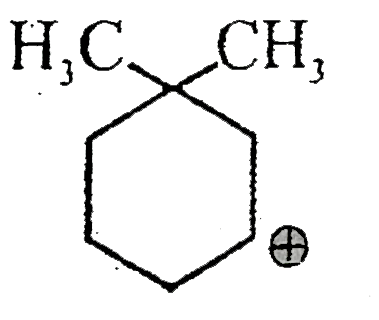Rearrangement is not possible in :-

CH3−C∣OCH3H−⊕CH−CH3

CH3−C∣CH3H−⊕CH−CH3
The correct Answer is:A
Step by step video, text & image solution for Rearrangement is not possible in :- by Chemistry experts to help you in doubts & scoring excellent marks in Class 12 exams.
Topper's Solved these Questions
Similar Questions
Rearrangement in Carbocation
View SolutionAcid catalysed hydration of alkene give alcohol. In thic reaction addition of water takes place according to Markownikov's rule. Since intermediate carbocation is formed in this reaction, rearrangment of carbocation takes place. In oxymercuration-demercuration reaction hydration of alkene takes place according to markownikov's rule. Oxymercuratio-demercuration-dermercuration no rearrangement is possible. in hydroboration-oxidation hydration of alkene takes place according to anti marjownikow's addition. in HBO reaction rearrangement is not possible. both in oxymercuration-demercuation and hydroboration-oxidation, intermediate carbocation are not formed.
Q. The product formed in the following reaction is:
 PruductView Solution
PruductView Solution
Knowledge Check
- Question 1 - Select One or More
In which of the following reactions, rearrangement is possible ?
AE1BSN1CSN2'DE1cB - Question 2 - Select One
Acid catalysed hydration of alkene give alcohol. In thic reaction addition of water takes place according to Markownikov's rule. Since intermediate carbocation is formed in this reaction, rearrangment of carbocation takes place. In oxymercuration-demercuration reaction hydration of alkene takes place according to markownikov's rule. Oxymercuratio-demercuration-dermercuration no rearrangement is possible. in hydroboration-oxidation hydration of alkene takes place according to anti marjownikow's addition. in HBO reaction rearrangement is not possible. both in oxymercuration-demercuation and hydroboration-oxidation, intermediate carbocation are not formed.
Q. CH3−C≡C−H(Sia)2HB−−−−−−−→H2O2/OH−A, A isACH3−CH2−CHOB CCH3−CHODCH3−CH2−CH2−OH
CCH3−CHODCH3−CH2−CH2−OH - Question 3 - Select One
Acid catalysed hydration of alkene give alcohol. In thic reaction addition of water takes place according to Markownikov's rule. Since intermediate carbocation is formed in this reaction, rearrangment of carbocation takes place. In oxymercuration-demercuration reaction hydration of alkene takes place according to markownikov's rule. Oxymercuratio-demercuration-dermercuration no rearrangement is possible. in hydroboration-oxidation hydration of alkene takes place according to anti marjownikow's addition. in HBO reaction rearrangement is not possible. both in oxymercuration-demercuation and hydroboration-oxidation, intermediate carbocation are not formed.
Q. The product formed in the following reaction is:
 PruductA2-phenyl-2-propanolB2-phenyl-1-propanolC3-phenyl-1-propanolD1-phrnyl-2-propanol
PruductA2-phenyl-2-propanolB2-phenyl-1-propanolC3-phenyl-1-propanolD1-phrnyl-2-propanol
Which of the following statements are not correctly associated with SN1 reaction?
I. Rearrangement is possible.
II. Rate is affected by solvent polarity.
III. The strength of the nucleophile is important in rate determining step.
IV. The reactivity order is : tertiary > secondary> primary
V. Proceeds with complete inversion of configuration.View SolutionWhich of the following phreases are not correvlty associated with SN1 reaction ?
(I) Rearrangement is possible
(II) Rate si affected by polarity of solvent
(III) the strength of the nuclephile is important in determining rate
(IV) the reacityity series is tertiary gt secondary gt promany
(V) proceeds with complete inversion of configguationView SolutionWhich of the following statement(s) is/are incorrect regarding SN1 reaction?
I) Rearrangement is possible.
II) Proceeds with complete inversion of configuration.
III) Rate depends on polarity of solvent.
IV) The strength of the nucleophile is important in rate determining step.View Solutionthe chromosomal rearrangement results in :
View SolutionBeckmann rearrangement is involved in the synthesis of
View Solution

